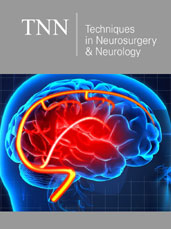- Submissions

Full Text
Techniques in Neurosurgery & Neurology
Craniosynostosis and the Role of Neurosurgeons
Ata Mahdkhah*, Ali Riazi, and Bahram Aminmansoor
Department of Neurosurgery, Isfahan University of Medical Sciences, Iran
*Corresponding author:Ata Mahdkhah, Department of Neurosurgery, Isfahan University of Medical Sciences, Isfahan, Iran
Submission: February 14, 2023;Published: April 18, 2023

ISSN 2637-7748
Volume5 Issue3
Introduction
Craniosynostosis is the premature closure of one or more of the cranial sutures, which leads to skull deformities and other complications. Its prevalence is about 1 in 1800-2500 newborns [1,2]. Craniosynostosis can be classified to syndromic and non-syndromic. Non- Syndromic Craniosynostosis (NSCS) usually involves only one cranial suture. Coronal, sagittal and metopic craniosynostosis are common forms of NSCS.
Crouzon, Apert, Pfeiffer, Muenke, and Saethre Chotzen syndromes are the five most common types of syndromic craniosynostosis. While each has altered genetic anomalies, their symbolic outcome is turribrachycephaly, most often associated with bi coronal craniosynostosis. The role of prenatal screening and advising is rising, with relatives becoming active earlier than delivery. Multidisciplinary attention from delivery ahead includes different specialists like neurosurgeons, orthodontists, otolaryngologists, craniofacial surgeons, ophthalmologists, plastic surgeons, anesthesiologists, pathologists, psychiatrist, speech therapists, and geneticists.
The main objectives of craniosynostosis reconstructive surgeries are to treat skull deformities and their potential complications, psychosocial and aesthetic considerations. There are different operative techniques to treat patients of UCS and MS in the literature ranging from a minimal endoscopic suturectomy to calvarial bone remodeling and noninvasive procedures to distraction osteogenesis [3-5]. The selection of each technique depends on the type of abnormality, experience of surgeon and severity of accompanying deformities [6- 8]. To compare many variables of the procedure with what we can find in literature, some similarity and matching of demographic data and surgical technique should be considered. Different surgical techniques have very different times of surgery and blood loss. The lower age of the patient makes the surgeon choose a simpler procedure such as endoscopy and older the patient, more extensive surgery to be selected [9,10].
Neurosurgeons are the main part in the diagnosis and treatment of patients with craniosynostosis. In fact, neurosurgical techniques can reverse skull deformities and prevent complications like increased Intra Cranial Pressure (ICP). In addition, the role of neurosurgeons in treatment of patients with craniosynostosis covers further than handling children in medical practice and contains research, education and preparation, and support advantages to encourage context-specific, evidence-based creativities to community health difficulties.
References
- Nagaraja S, Anslow P, Winter B (2013) Craniosynostosis. Clin Radiol 68(3): 284-292.
- Silav G, Avci G, Akan G, Taylan G, Elmaci I, et al. (2011) The surgical treatment of plagiocephaly. Turkish Neurosurg 21(3): 304-314.
- Barone CM, Jimenez DF (2004) Endoscopic approach to coronal craniosynostosis. Clin Plast Surg 31(3): 415-422.
- Anantheswar YN, Venkataramana NK (2009) Pediatric craniofacial surgery for craniosynostosis: Our experience and current concepts. J Pediatr Neurosci 4(2): 86-99.
- Jimenez DF, Barone CM, McGee ME, Cartwright CC, Baker CL (2004) Endoscopy-assisted wide-vertex craniectomy, barrel stave osteotomies, and postoperative helmet molding therapy in the management of sagittal suture craniosynostosis. J Neurosurg 100(5): 407-417.
- Vu HL, Panchal J, Parker EE, Levine NS, Francel P (2001) The timing of physiologic closure of the metopic suture: a review of 159 patients using reconstructed 3D CT scans of the craniofacial region. J Craniofacial Surg 12(6): 527-532.
- Kovács AF, Sauer SN, Stefenelli U, Klein C (2008) Growth of the orbit after fronto orbital advancement using nonrigid suture vs rigid plate fixation technique. J Pediatr Surg 43(11): 2075-2081.
- Yano H, Tanaka K, Sueyoshi O, Takahashi K, Hirata R, et al. (2006) Cranial vault distraction: Its illusionary effect and limitation. Plast Reconstr Surg 117(1): 193-201.
- Lekovic GP, Bristol RE, Rekate HL (2004) Cognitive impact of craniosynostosis. Semin Pediatr Neurol 11(4): 305-310.
- Bristol RE, Lekovic GP, Rekate HL (2004) The effects of craniosynostosis on the brain with respect to intracranial pressure. Semin Pediatr Neurol 11(4): 262-267.
© 2023 Ata Mahdkhah. This is an open access article distributed under the terms of the Creative Commons Attribution License , which permits unrestricted use, distribution, and build upon your work non-commercially.
 a Creative Commons Attribution 4.0 International License. Based on a work at www.crimsonpublishers.com.
Best viewed in
a Creative Commons Attribution 4.0 International License. Based on a work at www.crimsonpublishers.com.
Best viewed in 







.jpg)






























 Editorial Board Registrations
Editorial Board Registrations Submit your Article
Submit your Article Refer a Friend
Refer a Friend Advertise With Us
Advertise With Us
.jpg)






.jpg)














.bmp)
.jpg)
.png)
.jpg)










.jpg)






.png)

.png)



.png)






